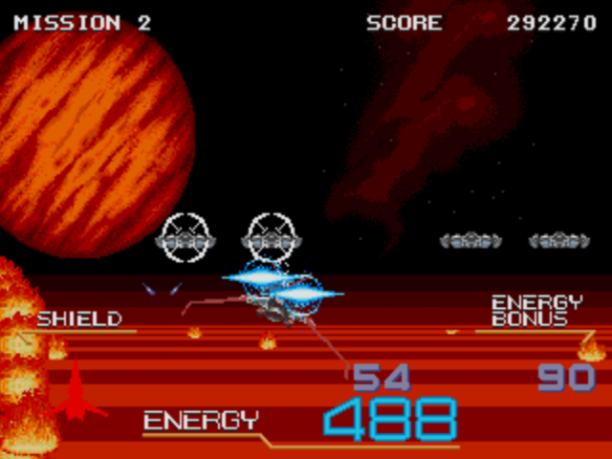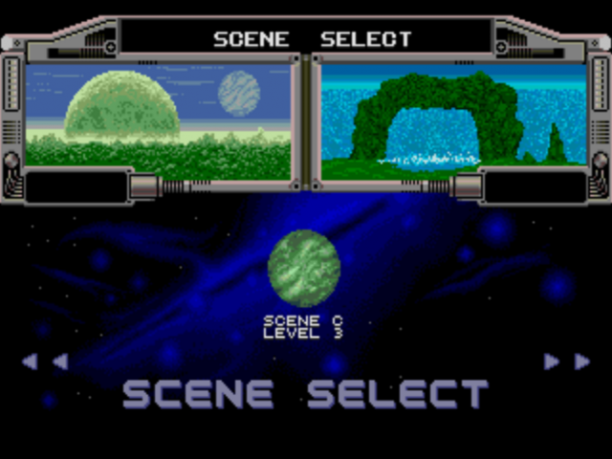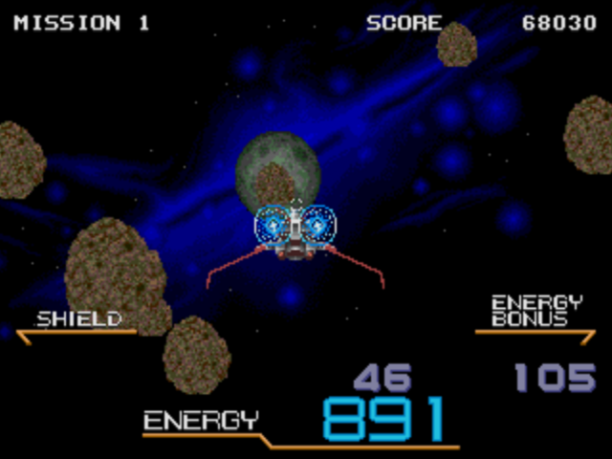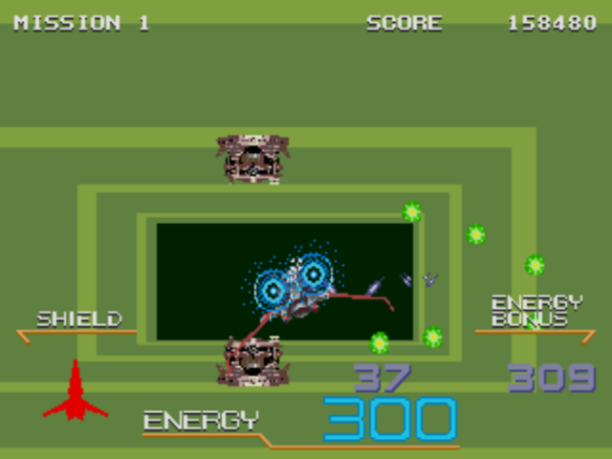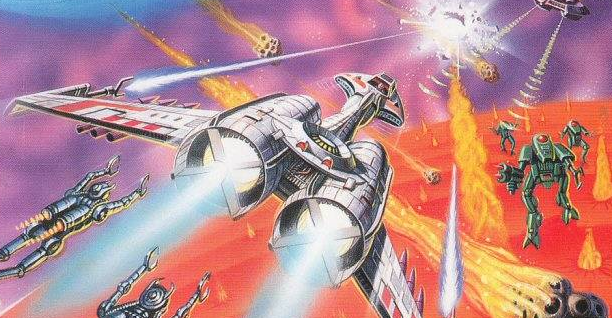
Pixel Gallery
Galaxy Force II
Retro Platforms: Amiga, Arcade, Atari ST, Commodore 64, Sega Genesis, Sega Master System, ZX Spectrum
Platform Reviewed: Sega Genesis
For whatever reason, many retro shooters are themed around space combat: maybe it’s because of a sense of grandiose exploration, perhaps being able to fly quickly in an unlimited space seems exhilarating, or it could just be that stars are really pretty to look at. Aliens have invaded planets, you guide a destined ship meant to save the universe, impossible odds, and so on. But despite the continued reliance on this type of adventure, developers manage to introduce unique atmospheres, ship designs, gameplay mechanics, and even camera styles to help vary things up. Galaxy Force II shows an early attempt to expand rail shooters into 3D, and it experiments with a timer-based health system, indoor and outdoor environmental transitions, and a behind-ship perspective. Despite being fun and creative, however, the game also suffers from some system limitations.
Graphics
Being separated into different planets and areas of space, Galaxy Force II manages to have levels with distinguishing natural effects: the first level features traversing past space terrain and asteroid belts, a later level involves a volcanic planet with launching fire effects, and another one includes vicious plants that appear over a forest. The variety is best conveyed in two particular areas: distinguishing (and appealing) color schemes for different planets, and pleasantly drawn backgrounds that provide sketches of atmosphere and galaxy depth; my favorite background details are the distant planets, showing spatial connection between worlds. Levels also scale with the player: horizontally as the player moves left and right, and forwardly as the ground advances in proportion with the player’s speed. But while the backgrounds are pleasing, and the stages update with the player’s navigation, the actual grounds aren’t that detailed: several stage floors are usually limited to simple rectangles or basic effects, and cave interiors all have similar kinds of designs. There are also some natural obstacles that fire upwards, but while they do move quickly, they’re often affected by limited draw distance.
The camera follows behind the player’s ship, and the actual levels manage to have convincing levels of 3D depth; indoor areas are especially built with this in mind, incorporating turns and ground bumps into the design. Combatants seem less elaborate, however, and due to the camera being directly behind you, some depth perception issues (mostly with enemy bullets) are present; enemies scale in size, which is impressive, but their projectiles are a different matter. Probably the biggest visual problems in Galaxy Force II are ones due to hardware limitations: some enemies tend to flicker in and out, and the game can have trouble tracking many objects without negatively impacting controls. But the animation has some positive aspects: impressive wavy effects exist, speed alterations look great, and a well-designed HUD rapidly updates while also being ideally laid out.
Audio
This game has some great music! The soundtrack consistently combines upbeat arcade rhythms with jazz themes, and it has a sense of smoothness that just feels really mellow. Each stage has different songs, all of which are both catchy and complementary with the gameplay. The music has multiple instruments, builds into new sections, and the songs actually evolve over time with added layering effects! What’s also really impressive is that the songs often last several minutes before looping, and their lengths match closely with some stage times, so the audio never feels overly repetitive. Subtle percussion is present, the Sega Genesis sound chip works well for the game feel, and there’s even some rhythmic bass in certain areas. The soundtrack’s not the best in the system’s library, but what’s here is pretty solid, and I found myself bouncing to the music at times.
The most impressive aspect of the sound effects is the voice acting, although it’s only present during cave settings and high score screens. Turning directions communicate upcoming curves, and although the quality is slightly compressed, the voicing does manage to play a small role in the gameplay. Regarding other sound effects, each type of attack and collision has its own noise, and there’s audio-based feedback to physical impacts as well. Everything sounds generally snazzy, and there aren’t any grating effects nor anything that sounds painful. Sound tests are also available in the options menu, and it can be fun to make cheesy remixes with the effects.
Gameplay
Galaxy Force II features a scoring system, with points being earned from covering distance and attacking enemies, but there’s also a primary objective: work your way through six different levels before running out of fuel. A play session starts by letting you select between five levels of varying lengths, and managing to complete all five of these without dying gives you a shot at a final hyperspace section; there’s a decent ending to earn as well, and it’s nice to see an arcade game that has multiple things to work for. Getting to choose the order that you play through levels is ideal for people who want to see most of the game across separate play sessions, and it ensures that you don’t have to repeat older sections in order to see the new stuff; the starting point is reflected in high scores too. Each level also has unique environmental theming, and encountered obstacles vary as well: a desert world features swirling tornadoes and ground robots, a volcanic area has targetable flares that shoot up from the ground, and a plant world has biological obstacles that can grow to entrap you, among other examples. There’s diversity between levels, and I feel that this really helps the gameplay presentation.
Besides steering around, there are four different button-controlled actions: speed up, speed down, fire pellets, and launch homing missiles. By default, firing pellets is an automatic feature due to the three-button limit on the original controller, but the controls can be changed in the options menu (which can also make speeding up the automatic action). Unfortunately, the default weapon is pretty weak: it requires incredibly precise aiming and doesn’t feel like it hits enemies very often. A more practical attack involves launching reloadable missiles: several enemies can be targeted at once, and more often than not, this works pretty accurately. Missiles also do greater amounts of damage against adversaries with higher health amounts, and occasional power-ups are provided to temporarily increase the strength of these weapons; it would be more engaging if you had to collect the power-ups instead of having them given to you, but it’s alright enough. Unfortunately, some enemies tend to flicker due to system limitations, and your movement’s slightly jerky when there are too many simultaneous objects present; the controls work adequately, but the frame rate’s sometimes slow, which leads to dodging not always feeling smooth. Environmental obstacles are noticeable despite some limited draw distances, but enemy projectiles sometimes have bad depth perception even though the enemies themselves are fun to face off against.
Rather than having instant death upon getting hit, Galaxy Force II has a somewhat complex set of rules regarding its health system. There’s a shield that limits damage until it’s fully used up, and there’s an additional energy meter that counts down to indicate your remaining fuel: once the fuel runs out, it’s off to the high score board. The energy meter effectively acts as a timer, but what’s interesting is that it lowers at the same rate regardless of how quickly you move: you can slow down (to more easily avoid enemies, but at the risk of running out of fuel), you can quickly speed through levels (while making it much harder to avoid collisions), or you can leave the ship’s speed to default levels (to strike a balance). You regain energy after caves and bosses, and the recovered amount’s based on how many enemies you killed during the level; this adds another balancing system since you need fuel to have a chance of beating the entire game, so some direct engagement is needed. In addition to time-based depletion, you also lose chunks of energy from land and weapon collisions, which is cool, but the combat’s a fairly mixed bag. Ultimately, I really like the health system, although it has some minor issues: recharging stations could be more frequent, and the experience rate for certain enemies seems too low.
The level design repeatedly switches between outdoor and indoor environments, with each having a unique sense of space. Outdoor environments showcase environmental effects, and your movement is hardly restricted in these areas; this lets you experiment with your speed and focus on enemy encounters. As mentioned earlier, these areas also have natural obstacles, which are fun to avoid when going at normal speeds, but their draw distances can be an issue while moving faster, especially when some obstacles are mine-like, triggering when you fly over them; this is another instance where the gameplay’s fun, but the difficulty’s impacted by technical limitations. Indoor environments switch between claustrophobic corridors and wider valleys, having floor dips and walls replace environmental traps; enemies are present too, but they’re more active threats here. The indoor environments are actually pretty satisfying presentation-wise, and voice alerts properly prepare you for tight turns that need to be made. Eventually, every level ends with a boss-like encounter, but there’s no real strategy to these moments since the targets don’t attack back: continuously spam missiles, acquire energy bonus.
The gameplay’s not the most advanced ever, and there aren’t many power-ups compared to most space shooters, but the action’s generally fun and relaxing minus some processing issues. There’s a lot of variety to the stage design, fighting is enjoyable more often than not, quickly moving is fun, and the choose-your-own-approach mechanics (thanks to stage selection and risk versus reward systems) add welcomed complexity onto an admittedly short yet appealing game. To add to this customization, Galaxy Force II has one of the better options menus that I’ve seen in a retro shooter: it offers energy countdown settings, shield strength customization, multiple difficulties, normal/inverted flight options, and four different control layouts. There are music and sound tests too, and the strength of the game’s soundtrack makes this a great feature to have!
Conclusion
I might seem overly critical when describing some of this game’s control limitations and visual problems, but that’s only to highlight both pros and cons. While it’s clear that many parts of the game have to work with limited resources, as shown by some jittery controls and an inconsistent visual quality, I feel that Galaxy Force II is ultimately a fun retro shooter that’s accompanied by vibrant backgrounds, a jazzy soundtrack, and unique gameplay mechanics. And with there being both high scores and a main story objective, there are multiple ways to have an enjoyable experience. However, Galaxy Force games are on other platforms as well, some of which control better, so I would recommend looking for a more detailed console release before buying the Sega Genesis version; if this is your only option though, then it’s still worth trying out, and I think you’ll be in for a pretty fun time!
